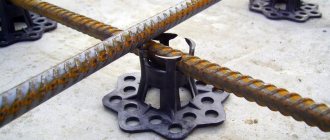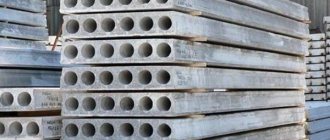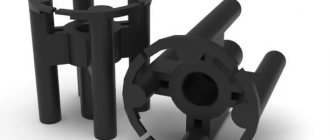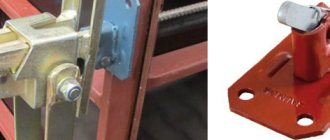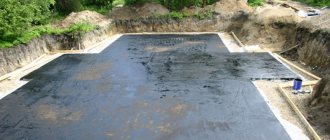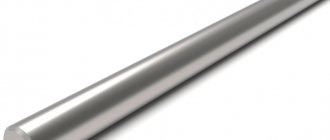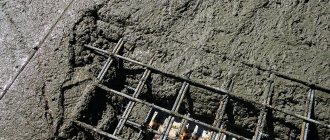The characteristics of concrete monoliths largely depend on the quality of the reinforcement, which distributes static and dynamic loads. Therefore, it must be correctly oriented in the thickness of the structural element and reliably protected from the external environment with a layer of concrete. For this purpose, reinforcement clamps are used - embedded elements designed to secure and hold the reinforcing structure until the concrete solution sets.
Protective layer of concrete and its functions
The distinctive properties of reinforced concrete are explained by the unique combination of physical and chemical properties of its components. The metal frame works in tension, while the concrete mass has high compressive strength. They have the same coefficient of thermal expansion. The hardened solution turns into an array of artificial stone with an alkaline environment, which becomes an excellent insulator for steel frame elements from corrosion. This insulation is effective when, after concreting, the distance between the reinforcement bars and the surface of the finished product is sufficient to prevent the penetration of water, oxygen, and other aggressive substances through the pores of the concrete to the surface of the metal products. The minimum value of this distance (usually 10-40 mm), called a protective layer, depends on the conditions of further operation of the reinforced concrete product or structure and the influence of various factors.
Compliance with the protective layer is a guarantee of the strength and reliability of the structure being built.
Building codes define the requirements for the thickness of the protective layer. After all, a thick layer increases the load on the frame, increases the weight of the structure and is more expensive, while a thin layer partially loses its functional characteristics. Determining the required concrete thickness is influenced by:
- type of structure being built (wall, column, staircase, foundation, ceiling);
- diameter of the reinforcement used;
- external environment and climatic zone (temperature range, maximums and differences; humidity; contact with the ground and others).
According to the standards, in the most common cases, the following recommendations on its thickness are relevant for regulating the protective layer of concrete:
- rooms with normal or low humidity - at least 20 mm;
- wet rooms without waterproofing – 25 mm or more;
- unprotected external surfaces of buildings - at least 30-40 mm;
- part of the structure buried in the ground that does not have additional protection – 40-76 mm;
- foundation – from 40 mm;
- floors up to 25 cm thick - from 12 mm; more thickened - from 17 mm.
Special magnetic control sensors help to find out the actual depth of reinforcement in finished reinforced concrete structures.
Features of using the knitting method
Reinforcement tying diagram.
Today, the method of knitting reinforcement rods to reinforce the foundation with a reinforcing cage is becoming increasingly popular on construction sites in the Russian Federation. This method deserves the greatest popularity in the segment of low-rise private construction.
Most often, tying the foundation frame reinforcement is done using the manual method, which requires the involvement of highly qualified specialists. The tools for doing hand knitting are simple household pliers or special hooks.
When manually tying reinforcement rods into a single reinforcement frame, it is necessary to splice the steel rods overlapping each other, followed by end-to-end tying of similar rods in several places (most often, tying is carried out in the center and along the edges of the bundle).
As a means for knitting, you can take steel wire with knitting properties, which has a cross-sectional diameter of a maximum of 1.2 mm.
The thickness of the wire in each case will depend on the individual parameters of the reinforcement bars that are used. If rods with a smooth profile were prepared for tying, the labor intensity of such work will increase significantly, because bending the hooks is necessary for successful tying.
This method of tying the foundation with reinforcement is distinguished by the high complexity of the technological process; therefore, today a large number of builders are trying to find an option to improve the tying technology and simplify it.
What provides the protective layer?
The location of the elements of the reinforcing frame before concreting can be verified, maintaining the required distance to the walls of the formwork and the base. But the possibility of displacement of individual elements from the flow of fresh concrete when filling and compacting the volume cannot be ruled out. At all stages of obtaining a reinforced concrete structure, the position of the metal elements and the entire frame will remain stable if clamps of the protective layer of reinforcement are used. The saying about a small, but no less expensive, spool is very relevant when applied to them.
Positive qualities of products and benefits from their use:
- The clamps are made of durable plastic - a material that is resistant to corrosion, temperature changes, and the effects of aggressive substances.
- The strength of the products allows you to maintain stability of geometric shape and size, and create a reinforced reinforcing frame for loaded structures.
- Versatility - they can be selected for any type and size of reinforcement, various methods of its fastening, and ensuring the required thickness of the protective concrete layer.
- Plastic supports for reinforcement are also used when concreting structures with a frame base made of composite materials.
- Mass produced retainers are interchangeable.
- The metal frame of the future reinforced concrete structure is assembled easily, quickly, without the use of welding or wire to fix a certain position of the rods relative to each other and the formwork.
- They prevent the frame mesh from appearing above the concrete surface and keep it in a fixed position.
- Support for metal reinforcement prevents concrete from cracking because it minimizes bending and deformation of the rods under the significant weight of the structure.
- They help maintain a constant required thickness of the protective layer.
Made from plastic, the fasteners are a consumable item that remains in the poured concrete. Very rarely, being an element of the formwork, the support for the reinforcement can be reusable. Working with such a product (for example, a cone-type reinforcement clamp) involves dismantling and filling the remaining cavity with solution.
The orientation of the reinforcement affects the classification of the fasteners used with it, which can be:
- support – to fix the position of the frame in the horizontal plane;
- wall - for vertically directed reinforcement (the most used is the star reinforcement clamp);
- universal – combining the capabilities of the first types;
- special - for use in special cases and specific situations; Such fasteners include plugs and tubes, which create the necessary cavity in the concrete and provide the required distance to the reinforcement from the surface of the future product.
The optimal principle for placing clamps in the body of the future product is a checkerboard pattern. With this arrangement, the recommended interval between them is 50-90 cm. The specific value is selected taking into account the dimensions of the metal frame, the cross-section of its rods and the design features of the clamps themselves. According to building regulations, the usual consumption of reinforcement clamps is 4-10 pcs/m2.
Mesh on plastic supports for reinforcement, arranged in a checkerboard pattern, every 80 cm, consumption 5 pieces per square meter.
Types of fasteners
Manufacturers present an impressive range of products of various types. The production of plastic fasteners for fittings is constantly introducing new developments. Already well-known designs are being refined and improved. Let's take a closer look at the most popular of them.
"Cube"
A universal embedded element that can withstand heavy loads due to its thickened wall. A reinforced version of the clamps can serve as a support for reinforcement with a diameter of up to 40 mm, and provide a protective layer from 35 to 80 mm. The most popular is the cube retainer with a wall thickness of 2.1 mm, provides a protective layer of 35, 40, 45 and 50 mm in size, and is used for reinforcement with a diameter of no more than 28 mm.
"High Chair"
The most common support clamps for metal reinforcement when reinforcing ceilings, floors and other horizontal planes. The shape is a cylindrical barrel with four grooves and open bridges at the top. The usual version has 4 legs, the reinforced version has 5. The fixture for the reinforcement is a “chair”, has a fixed size, and can provide a protective layer in sizes of 15, 20, 25, 30, 35 and 40 mm, the choice of the required size is carried out according to the requirements of the drawing structural reinforcement. This type of clamp is suitable for fittings with a diameter of 4 to 14 mm.
"Herringbone"
A modified version of the chair, which has 2 pairs of inclined bars at the top. The products allow you to obtain 4 different layers of the required concrete protection - 20, 25, 30 and 35 mm. Suitable for metal rods with a diameter of up to 20 mm.
"Cone"
The clamp is installed at the ends of the tube. The role of the tube is to form a through hole in the mass of poured concrete for the formwork tie bolt. The function of the cone is to prevent concrete from getting inside the tube. After removing the formwork, the cone can be reused.
"Star"
A common product in monolithic construction, which received this name due to its star-like appearance. Designed for vertical fixation of the reinforcing frame and creating a gap between it and the formwork. The star lock helps to obtain one option for the thickness of concrete protection, ranging from 15 to 75 mm. Used for fittings with a diameter from 4 to 22 mm.
"Rack"
The cylindrical reinforcement clamp rack is very similar to a cube. By installing it on top of each other, you can hold several rows of reinforcing mesh at one point, but at different levels.
Important! If the concrete surface will be formed on a layer of waterproofing or on a loose base, it is recommended to use an additional “base” fixer. It prevents the supporting legs or body of the main product from breaking through the waterproofing layer; prevents unwanted immersion of the fixer into loose sand or gravel with the inevitable disruption of the uniformity of the protective layer in this area.
Homemade clamps and supports for reinforcement
The desire to save money, small volumes of individual construction, the impossibility of purchasing or the urgency of completing the work encourages the use of improvised means (brick, paving slabs, wooden beams, paving stones) and various devices made independently as a stand for fittings.
Note! Wood and brick have increased water absorption. Wooden blocks also swell subsequently, and in the future they generally collapse. Therefore, such options for stands are unacceptable, since in the area where they are installed, the reinforced concrete structure loses its reliability.
Often bars or elements of the desired shape are cast from concrete. Their advantages are good adhesion to poured concrete due to the same structure, very high strength indicators. The main disadvantage is that the support does not reliably fix the frame, which can move when the solution is supplied to the work area.
Craftsmen can also use the following self-made fasteners for fittings:
- a plastic retainer made from a sewer plastic pipe in which the necessary grooves or holes are made for laying the fittings;
- socket boxes with and without cuts for fixing fittings.
Plastic embedded clamps simplify the process of self-assembly of a metal reinforcing frame and significantly speed it up. After pouring concrete, the frame has a guaranteed protective layer on all sides. This is the key to long and safe operation of the resulting reinforced concrete structure or its individual element. And simple plastic fixtures for fittings help achieve this result.
Various plastic adapters work well in tandem with the protective layer clamps. They increase the supporting area of the frame on loose surfaces, help regulate the size of the concrete protection layer, and expand the possibilities for optimal use of standard fasteners without the cost of additional highly specialized products.
Installation of reinforcement for formwork
A process such as installing reinforcement for formwork requires care and caution, as well as strict adherence to the sequence of work. In order to correctly lay the entire frame into the formwork, it is necessary to lay it in segments. Before the installation of the frame begins, we place large stones of the same height into the formwork at the bottom of the trench. They will support the frame and provide the necessary distance between it and the pillow. Watch the video on how to correctly lay reinforcement in the formwork.
The frame fragments must be laid in such a way as to maintain the exact distance between the formwork and the sides of the metal structure. Each subsequent fragment is securely fastened to the previous one. The fastening is a knitting wire, tightly twisted using a special hook.
When fastening the frame fragments, you need to remember that you will have to twist the wire firmly and reliably. It should hold the structure, protecting it from being squeezed out.
The frame must be laid in the formwork so that the rods in the corners match in length and level along the entire length of the foundation. They are fastened after placing one on top of the other, using the same knitting wire. Installation of the reinforcement frame in the strip foundation formwork, done correctly, guarantees a long service life and strength of the foundation for the entire building. When pouring concrete, we must not forget about tamping, which will get rid of air bubbles and maintain the strength of reinforced concrete.
Choosing fasteners - advice from an expert
In my 10 years of practice in monolithic construction, I quite often encountered the problem of defective fasteners. After installing them under the reinforcing mesh, and then stepping on it, the stands simply scattered to the sides. They broke in half, and the mesh was lowered onto the formwork. There was also a case with the “star” fasteners; during installation on the reinforcing mesh, they simply flew apart, half the bag was simply thrown into the air. The problem was low-quality plastic; it was fragile.
When purchasing, I advise you to open the bag with plastic stands and check them. If it's a chair, stand on it, it shouldn't break, it might just bend. The fastener is an asterisk, try to put it on something of a suitable diameter, bend it, it should not break. Plastic must be flexible and at the same time strong. If everything is ok, buy it.
Currently, the range of fasteners for fittings is simply huge, and every year it is growing all the time. New companies, new forms appear, but their goal remains the same, which is to provide the necessary protective layer to the reinforcement so that the structure you are building is strong and reliable.
